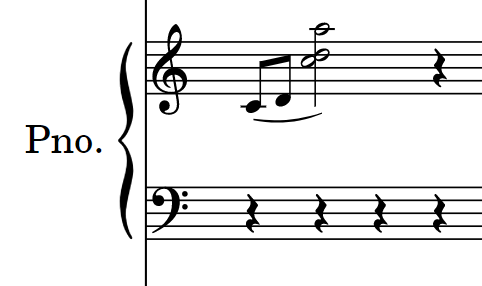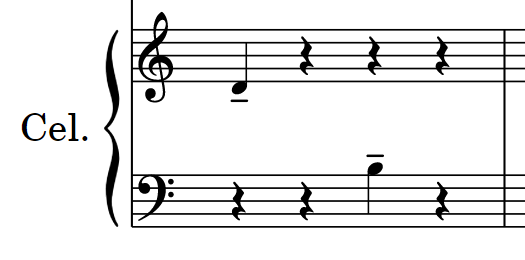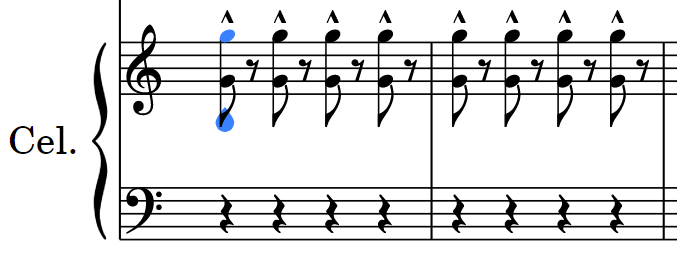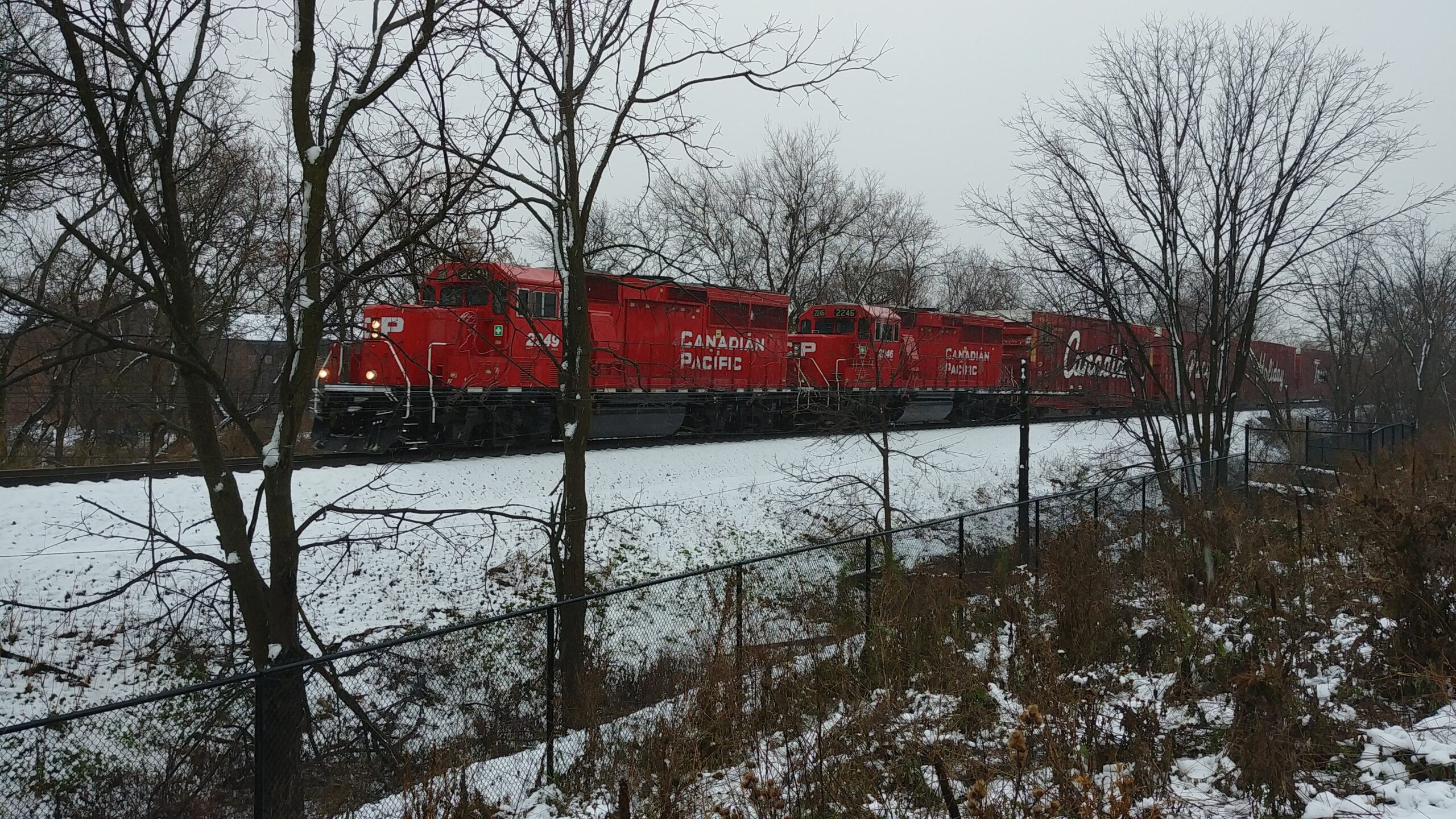Rhythms On The Railway: Notating Commonly Heard Sounds On Railways in Toronto, The GTA, and Southern Ontario
While railway history is a big passion of mine, my education and training is in the field of music. I have been a musician for nearly twenty years, and received a Bachelor and a Masters Degree in Music Therapy from Wilfrid Laurier University in Waterloo. Just over one year ago, a historical inquiry was sent to us asking if an old Toronto Union Station PA chime could be made into a phone ringtone. The History Team was able to find a video clip containing this chime, however it could not be shared due to copyright regulations. In order to accommodate this request, I used my musical ear to identify the notes, enter them into a music notation program, and then edited the audio to emulate the original chime.
Working on that project reminded me that all the sounds and chimes associated with railway operations contain notes, chords, and other musical components. Furthermore, these sounds are intentionally designed to either elicit a response (a blasting train horn is a warning to get out of the way), or cause us to think a certain way (chime on a TTC subway announcing the doors are about to close).
This blog post seeks to identify and notate the chords and notes present in commonly heard railway sounds, primarily in Toronto, but also in the GTA and Southern Ontario. This list will not be exhaustive, as there are too many of these sounds to fit into one article. Instead, this post is intended to serve as a compilation of some of the most common examples of these sounds.
For notating each example I used Google Flat. I find it to be a great free resource to make basic notations for teaching and other musical purposes. For audio extraction, editing, and effects, I used Audacity. I’ve included a glossary of musical terms I’ve used at the bottom of this article. Words in bold are musical terms that can be found in this glossary.
Despite my best efforts, I couldn’t locate a photo in my collection for the cover image that had both trains and music in it. I went for a photo I took of the combined CP Holiday trainset in Whitby in 2018 deadheading to Montreal. Given its history of musical performances at each stop on its journey, I felt it appropriately represented the theme of this article.
Lastly, the two video links located below for reference are the sole property of the creators. Myself and the TRHA do not make any claims of ownership, nor is any revenue being generated from their inclusion. The clips are being included solely for reference purposes. Full credit to each creator has been included in the “References” section at the bottom of this article.
Union Station PA Chime
As mentioned, this was the sound that inspired the idea for this project. This chime would be played through speakers in Union Station to signal an upcoming announcement over the station PA to passengers. An example of this chime can be heard at the 56:38 mark of this video, which was filmed in January 1990.
A piano was used to create this prerecorded chime. The chord present in this chime is a B dominant seventh. This five note arpeggio starts on a B, before rising to an A and descending to a F# and D#, to end where it started on B. All the pitches in this arpeggio are eighth notes of equal length.
In order to achieve the reverb heard in the original example, I wrote the arpeggio as shorter sixteenth notes, essentially doubling each note. I alternated between a louder forte and a softer piano dynamic for each note to simulate the notes echoing in the station. Using Audacity, I increased reverb levels to further exaggerate this echo

Modern VIA Rail PA Chime #1
At some point between 1990 and today, additional station chimes have been developed for use at stations on the VIA network. I have personally heard this first example played at the Stratford and Woodstock stations. It is generally followed by either an announcement about an upcoming a train, or a warning that high speed trains can pass through the area unexpectedly.
Like the older version, a piano is used to create this prerecorded chime. It begins with two ascending eighth notes using the pitches C and D. It then quickly jumps up about one and a half octaves to a D minor seventh chord in third inversion. This chord is played once and is held for about two beats. A half note rhythm was used to represent this.

Modern VIA Rail PA Chime #2
When researching the first chime, I came across this video taken at the Kingston VIA station demonstrating a second VIA Rail PA chime. I can recall hearing this chime while waiting for trains at the Kitchener VIA Station when I was a university student. It generally played when the train was a couple minutes away from arriving at the station.
This chime uses electronic tones that sound similar to a steel drum. It is a four note chime containing the notes G, D, E, and C. After listening to the chime multiple times, there appears to be an upper and lower voice played one octave apart from each other. Unfortunately there is no steel drum option on Google Flat, so I had to settle for the marimba setting.

TTC Subway Door Chime (Versions 1 & 2)
Anyone who has taken the subway will have heard these chimes at some point. These chimes serve to warn passengers that the doors on each car are about to close. They are typically also paired with a pre-recorded voice message warning passengers to stand clear of the doors.
An electronic tone is used to create these sounds. Not being able to find that exact sound on my notation program, I instead used the violin tone to replicate the sound. Likely as close as I can get with the resources I have available.

At some point, the triad used for these door chimes was raised up a whole tone. F, D, and Bb were raised up to G, E, and C. While the notes changed, the rhythm and phrasing remains the same. A single G is played when the doors open, and a descending G, E, and C triad is played when the doors close. The triad notes sustain into each other just like the first example.

I will confess that my knowledge of the TTC is pretty limited. I do not know what year each version of these chimes were introduced, or what other examples would have been in the early days of the TTC. I’d love to learn more from people with increased knowledge of this topic.
GO Train Onboard Station Chime
This next example is also our shortest example, being only two notes long. This chime is heard on GO trains operating in and around Toronto and the GTA as they approach stations along the GO Transit network. A celeste was used to replicate this chime. The two notes used are D and B. I added tenuto markings above each note to make their sound slightly longer.
This chime signals an upcoming pre-recorded announcement about what station is next, and what side of the coach the doors will be opening on. For example, if a train was about to arrive at Guildwood Station, this chime would play, then the voice would state “now arriving at, Guildwood, Guildwood Station. Doors will open on the right/left” (which option will depend on direction of travel and what platform is used). It might also follow an announcement from the on board attendant about platform construction at a station that impacts which coaches can be used to board/depart the train.

TTC Subway Station Trumpet Chime
As a resident of Stratford, I don’t get the chance to ride trains in Toronto like I did while living closer to Toronto. Most of these examples have been created by my own recollections from trips, and using videos online as a reference. This example was easy to recall in terms of my past experiences riding the TTC subway, but determining the reason for its use is still something I’m not familiar with.
I have heard this three note trumpet chime while waiting on the platform for the subway to arrive. It consists of three triplet eighth notes. At concert pitch, the notes used are Bb, C, and Eb. Since a standard trumpet is pitched to Bb, or a whole tone below concern pitch, the actual note names are C, D, and F.
With Audacity, I added on a large amount of reverb and widened the sound to emulate its echo off the walls of the subway platform and tunnels.

E-Bell (Graham White)
The e-bell, or electronic bell, has become the standard bell heard on most trains entering and exiting Toronto. Instead of a physical clapper striking the bell, an electronic chime is projected out of the bell, which is typically mounted at the front of the locomotive either near the headlight, or under the frame by the front wheelset. GO cabcars also typically have this type of bell mounted on them. The kind most commonly heard on engines is manufactured by Graham White, and as such are referred to as a Graham White e-bell.
This e-bell rings two G pitches an octave apart simultaneously every time it is struck. This sequence repeats using a constant rhythm until it is shut off by the engineer. To demonstrate this sound, I have used the celeste setting since unfortunately none of the bell settings I have on Google Flat sounded anywhere close. To emulate its use on an operating train, I have repeated the note eight times using eighth notes to give it a consistent bell chime sound. Some adjustment to the sound levels was done in Audacity in order to bring the higher tones to the front of the sound over the lower tones.

***AUTHOR’S NOTE*** At the time this is being written, It should be noted, based on recent observations, that some VIA Rail engines are seemingly replacing their e-bells with a newer kind. From what I’ve heard, it sounds like it is tuned to a F pitch, however I am unclear if there are other octaves or additional tones/overtones. More research is required before I can confidently notate this type of new e-bell.
TTC CLRV Streetcar Bell
Toronto and the TTC have used many different types of streetcars in their respective histories. I decided to go with the Canadian Light Rail Vehicle (CLRV) version since they are the type I can remember riding as a child. These types of streetcars plied the lines across the city before being replaced by the current Bombardier models in the 2010s.
It was tricky to find an example of what this bell sounded like. After reviewing a couple of videos, it appears that the bells on the CLVR streetcars chimed a single C pitch every time they were rung. On some recordings I’ve reviewed, it sounds as a single pitch. On others, it sounds as if an additional pitch, or possible overtones, might be audible. Given that a single bell is used, I’m going to go with the single pitch option.
To capture this tone, I used the tubular bell sound on Google Flat. I notated it as a short two eighth note chime to replicate how it would have been used by drivers. Given the tonal quality of a bell, it is more effective if multiple short tones are used instead of one long tone as bell tones decay immediately after they are struck.

Via Rail F40PH-3 Horn
I should acknowledge for these final two examples that train horn notation can be rather tricky. While a fleet of locomotives might at one time all have the same or similar horns, that can change over time due to maintenance and repair needs. Also elements such as air temperature, air flow, and obstruction from snow and other objects can change the tuning of a train horn on a given day. That being said, I hear VIA train 84 operating from Sarnia to Toronto every morning around 11:15am while working from my home two blocks from the Stratford train station. Over time, I’ve been able to pick up on the chords I hear the most often on this train as it passes through.
It would seem, at least in the year 2022, that a F40PH-3 model of engine seems to lead train 84 the most frequently. The horn I hear most often on this train contains the notes C, Eb, and Bb from low to high pitch. It is tricky to categorize this chord given the pitch names, but I tend to refer to it as an Ab 9 chord in first inversion. While there is no Ab present in the chord, the high Bb adds dissonance to the chord and and naturally wants to fall down a note to Ab. The horn pitches are generally played simultaneously, with the high pitch occasionally getting lost depending on how gentle or firmly the engineer blows on the horn.
To capture this chord, I used the French Horn sound on Google Flat. I then played around with distortion levels to give the notes some extra bite, settling on a middle of the road overdrive setting. Trains in Canada are required to blow their horn four times before entering a level crossing. Two long blasts, one short blast, and then a final long blast. I’ve used dotted quarter notes to emulate the long blasts, and a single quarter note to emulate the short blasts.

I walked over to the Stratford station a few days before Christmas to make sure I had the correct horn associated with the correct engine type. I do trust my ear, but since I usually only hear the trains from my house and don’t actually see them, I wanted to put eyes on the train in order to be certain. In the video included below, despite a wonky first blast, you can hear that the horn matches the example I notated. An example of the newer e-bell can also be heard in this video
VIA Rail P42DC Horn
While a F40PH-3 is primarily the unit on the point of VIA 84, a P42DC takes on the task from time to time. Earlier this month, the presence of a differently pitched horn told me that one of these units was passing through town. I quickly grabbed some paper, went to the piano, and set out to notate the horn.

Turns out that while it sounded different then the horn I heard when a F40PH-3 pulled the train, they were almost the same. Three pitches are heard in this horn. From low to high we have C, Eb, and A. Two of the three pitches were the same as the horn heard on the F40PH-3, and the upper pitch is only one semitone lower.
Since I didn’t see the train, I don’t know what the number was on the engine pulling the train. From researching online, I can say that VIA P42DC #912 does have a horn with these pitches on it, at least as of December 2022.
I spent a lot of time in Audacity tweaking the distortion to try to capture the rumbly sound of this horn without sacrificing sound quality. In the end, I went for a soft overdrive with the levels pulled back slightly to generate vibration.
Musical Glossary (in alphabetic order)
Arpeggio: A chord that is broken up and played one note at a time. Can be done with any combination of notes in a chord in any direction
Concert Pitch: A standard tuning method that the majority of western tonal instruments follow. In this tuning, a note appears as it is listed without any transposing or alterations
Dissonance: Unstable musical intervals that are often used to generate tension and emotion in music
Dynamics: Volume levels present in music
Eighth Notes: Notes that are half a beat long. They are drawn as a solid circle with a straight stem extending either up or down depending on the pitch, and have a single tail angling off the end. Eight of these notes can be found in a four beat measure. Multiples of this kind of note can be connect with a beam
First Inversion: A chord in which the lowest note is inverted and added to the top of the chord. The first possible inversion of a chord
Forte: A type of dynamic. Means to play loud, strong, or with force
Half Note: Notes that are two beats long. They are drawn as a hollow circle with a straight stem extending either up or down depending on the pitch. Two of these notes can be found in a four beat measure
Overtones: Frequencies contained within a pitch or sound that are higher then the original or primary pitch
Piano: A type of dynamic. Means to play softly
Reverb: The process of soundwaves sustaining themselves by reflecting off of surfaces such as walls and ceilings. Short for reverberation
Semitone: Smallest interval possible in Western tonal music. The gap between each note in a chromatic scale. The distance between a white and black key on a piano, and vice versa
Sixteenth Note: Notes that are a quarter of a beat long. They are drawn as a solid circle with a straight stem extending either up or down depending on the pitch, and have two tails angling off the end. Sixteen of these notes can be found in a four beat measure. Multiples of this type of note can be connected by a beam
Tenuto: A type of articulation where notes are separate but have a softer attach. Often played as a “dah” rather then a “tah”
Third Inversion: A chord in which the lowest three notes are inverted and added to the top of the chord. The third possible inversion of a chord
Triplet: A rhythmic grouping consisting of three even beats. Can be applied to all commonly used rhythms in Western tonal music
Whole Tone: An interval consisting of two semitones. The distance between most white keys on a piano, and most notes in the musical alphabet of A-G
References
Allen, D. [@danielallen9792]. VIA 84 Arriving In Stratford [Video]. YouTube. https://youtu.be/1RsuvO8mtHU
Barnes, P.J. [@Retro Rail Media/Video Classics]. VIA Rail: The Final 7 Days (1990 Video Classics [Video]. YouTube. https://www.youtube.com/watch?v=LSRJ4uNudmY&ab_channel=RetroRailMedia
ICTSProductions. [@TTCVIAFAn25]. (2015, November 28th). VIA Rail Train 643 Arriving at Kingston VIA Station [Video]. YouTube. https://www.youtube.com/watch?v=V0IIRvw4LX8&ab_channel=ICTSProductions
Laitz, S.G. (2008). The Complete Musician: An Integrated Approach to Tonal Theory, Analysis, and Listening (2nd ed.). Oxford University Press.


